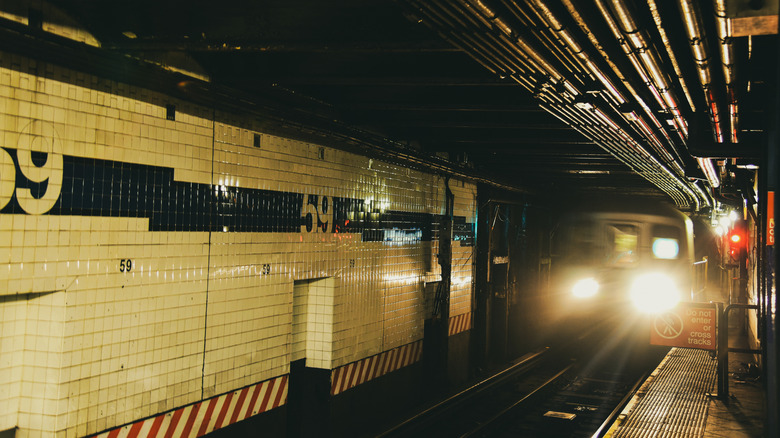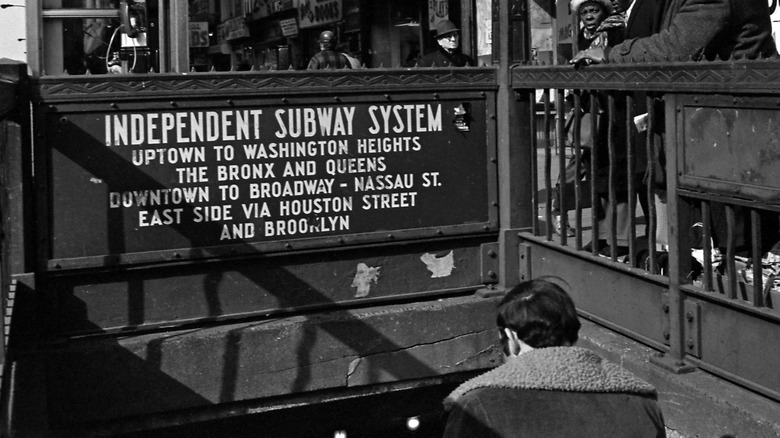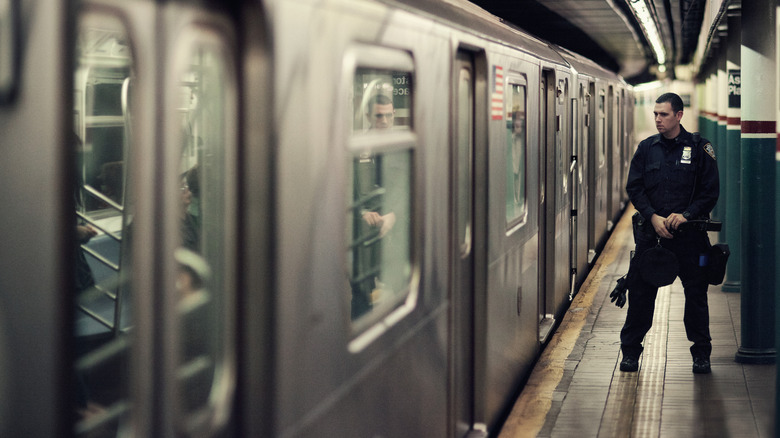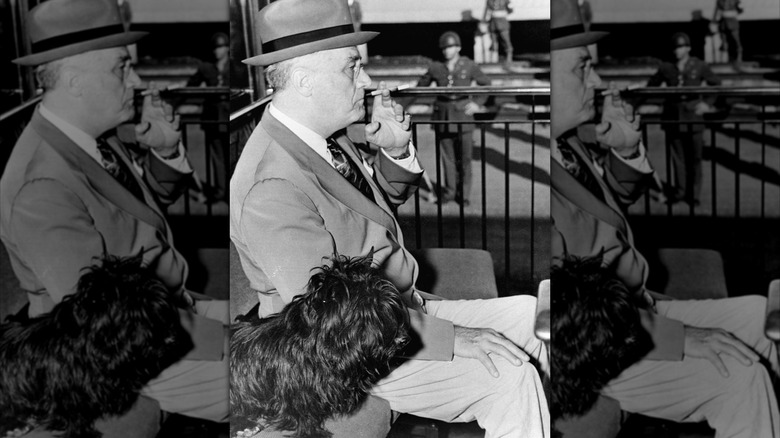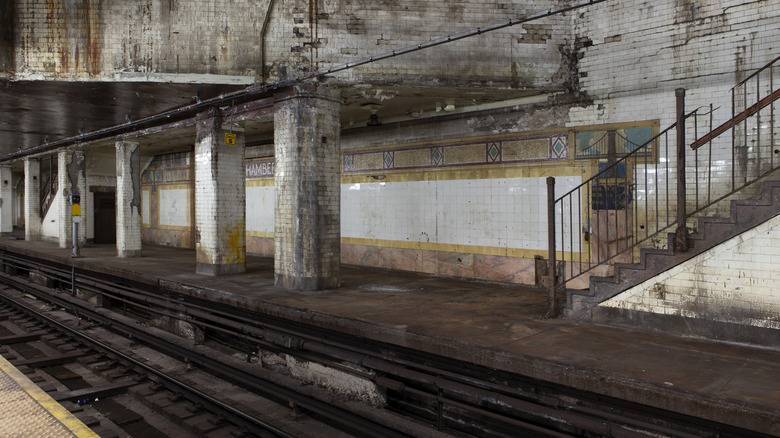The Creepiest Urban Legends About NYC Subways
While walking the storied streets of New York City, amid the hundreds of skyscrapers soaring upward, it may prove difficult to comprehend that you're also standing atop a vast system of subterranean tunnels that extend, in places, to a depth of more than 150 feet below the surface. There, the Big Apple's numerous subway lines shuttle commuters throughout Manhattan and beyond, a system that's been serving that purpose for more than a century, ever since the subway's grand opening in 1904.
Given the excessive traffic congestion in a city of nearly 8.5 million people (as of mid-2024), the subway remains the fastest way to get from point A to point B. That said, riding the various lines is not for the squeamish, and subway stories can run the gamut from ridiculous to horrifying. In fact, it's not unusual to encounter bizarre sights, strange people, and even perilous situations — often all at the same time — inside a subway train.
Throughout history, there have been various myths and legends based on disturbing truths, so why should the murky underground world of New York's subways be any different? From the mysterious subway denizens who exist in darkness far below the streets to ghostly apparitions, here are some of the creepiest urban legends about NYC subways.
Mole people
The Man of Steel once battled subterranean humanoids in 1951's "Superman and the Mole Men," while an American president believed that mole people lived in the Earth's Core. In New York, however, there have been various accounts of a different breed of mole people, unhoused denizens of the city who live within the vast network of underground tunnels.
"They knew the city's secrets," "Underground" author Will Hunt told NPR's "Fresh Air." "They knew the subterranean rivers and the abandoned subway stations and all of these places that the people on the surface never think about." According to Hunt, the mole people population exploded during the 1980s, and while it has since diminished, these underground subway dwellers still exist. "There's a tunnel that runs under Riverside Park that is where they used to live, and they had built an amazing shantytown down in the tunnel," Hunt said of what came to be called the Freedom Tunnel, since cleared to make way for train service.
Filmmaker Erik K. Swanson became fascinated by the mole people, and wound up befriending two of them. They invited him down to their underground home, and allowed him to film them for a documentary. As he wrote on his website, their living conditions were far less squalid that one might imagine. "I was astonished by the level of comfort they had each created for themselves in the tunnel," he wrote. "They had all the comforts of home — computers, refrigerators, etc."
The ghost train of Astor Place station
Astor Place Station opened to the public in 1904, situated at the convergence of the East Village and NoHo. One of the city's oldest subway stations, it's also rumored to be the most haunted. Over the years, there have been numerous sightings of a spectral old-timey subway car cruising along the rails. In fact, one subway rider claims to have actually boarded the phantom train.
The train in question belonged to August Belmont Jr., a banker who financed the construction of the subway. His private train car, dubbed Mineola, boasted mahogany panels, silk draperies, a galley (which included a stove to cook steaks), and even a reclining sofa. The train was specially constructed for Belmont, who used it to entertain friends while transporting them to Belmont Park Racetrack in Queens (which he had also financed) via a direct line from Grand Central Terminal.
In his book, "Haunted Greenwich Village: Bohemian Banshees, Spooky Sites, and Gonzo Ghost Walks," author Tom Ogden offered a pseudo-scientific theory about the phenomenon responsible for the ghost train. "What appears to be a haunting might really be a sudden shift in time, an occurrence that's been termed retrocognition," he wrote, as excerpted by AMNY. What Ogden is referencing has also been described as a time slip, a speculated phenomenon in which people claim to briefly experience an earlier era, but at the same location. "Such displacements," Ogden added, "are extraordinarily rare, instantaneous, and usually very brief."
The ghost of FDR haunts Track 61
Few people know about Track 61, a secret subway track hidden beneath Grand Central Station. That track, long unused, once served a singular and important purpose: to covertly transport President Franklin Delano Roosevelt from Grand Central to the Waldorf Astoria Hotel, where he stayed when in New York City.
He made the journey in a custom-made five-car train that was enhanced with bulletproof glass and armored plating. The track was kept secret in order to keep the public from finding out he was paralyzed from the waist down, part of the deception behind how FDR convinced America he could walk. "It was designed for the fact that he was handicapped," historian Phil Schoenberg, founder of Ghost Walks NYC, told WNYC. The train stopped at a secret station directly beneath the hotel, with Roosevelt then transported to an elevator that whisked him inside the hotel's underground parking garage.
During those train rides, Roosevelt was typically accompanied by his beloved Scottish terrier, Fala. Nowadays, various people claim to have encountered the ghost of the one-time "First Dog." "There's still a ghostly presence — Fala," Schoenberg said. "Apparently he still appears in Grand Central, still looking for his master. He's been spotted late at night by various people who are in the station to fix things or clean up."
The 76th Street Ghost Station
The 76th Street subway station in Queens has taken on a mythical aura, largely due to rampant speculation over whether it actually exists. The mysterious station has long been rumored to be located east of Euclid Avenue Station, part of an aborted plan to extend the subway line. However, the station appears on no map, can't be reached by any train, and nobody has ever provided any proof of its existence.
One person who believed the station to be real was Steve Krokowsi. A retired NYC transit worker, he offered The New York Times a few dubious pieces of evidence, including a claim that the control board in Euclid Station once featured a stop marked 76th Street that had been covered by black tape. He also said he'd heard tell of a guy who entered a long-lost door in a subway tunnel, and found himself in the station.
Some who've gone exploring in the tunnels have taken photos of a mysterious offshoot track that suddenly stops at a concrete wall. In addition, the site provided an intriguing footnote: a law office sits atop where the station is claimed to be and is recessed from the street, behind a patch of concrete that is the precise size as the entrance to a subway station.
